Brother Sergeant John Carmichael VC
(1 April 1893 – 26 December 1977)
Memorial Stone Ceremony – Friday 8th September 2017 – Glenmavis Parish Church
100 years ago, on the 8th September 1917, 24 year old Sgt John Carmichael of Glenmavis, Lanarkshire, Scotland, amember of Lodge New Monkland Montrose No. 88, was supervising a team of soldiers digging and extending a new section of a trench near Hill 60 at Zwarteleen, Belgium. While excavating the trench, Carmichael saw that a grenade had been unearthed and the fuse had started to burn. Sgt Carmichael recalled what happened;
“We were on Hill 60, digging a communication trench, and I was detailed off with a party of men to get it done quick. I was supervising the job. We had men working in the trench and men working outside of it as well. One of the chaps was deepening the trench when his spade struck an unexploded grenade, just lodged there in the side of this trench, and it started to fizz. I was an instructor in bombing, so, knowing a bit about explosives, I knew that there would be seven seconds before it went off unless I did something. I couldn’t throw it out, because there were men working outside the trench as well as the blokes in it. So I shouted at them to get clear and I had some idea of smothering it, to get the thing covered, keep it down until they were out of range. All I had was my steel helmet. So I took it off my head, put it over the grenade as it was fizzing away, and stood on it. It was the only way to do it. There was no thought of bravery or anything like that. I was there with the men to do the job, and that’s what mattered. Well, it did go off. They tell me it blew me right out of the trench, but I don’t remember that. The next thing I remember was being carried away.”
Carmichael’s both legs had been shattered and his right arm injured, it was a miracle no one else was hurt
It was several days before Carmichael knew anything what happened and he remembered nothing about the journey to No. 53 Casualty Clearing Station at Bailleul, nor of the first few days he spent there. Nor could he understand the fuss that was being made of him, or the flutter in the ward the morning that they told him he was to have a very special visitor — the General himself was coming to see him.
Sergeant J. Carmichael VC, 9th Btn., North Staffordshire Regiment would later recall;
“His name was General Williams, and he was very nice to me. They’d put me in clean pyjamas, and he patted me on the shoulder and called me ‘my boy’ and then he told me about the medal. I suppose I was pleased, but I’ve never been more surprised. And I was more pleased yet when my platoon came —the whole lot of them. I don’t know how they did it, managing to come together, but they came into the ward and they lined up at the foot of the bed and every one of them saluted me. Oh, I was embarrassed, but it was a great feeling. It was very good of them. They said I’d saved their lives, but I was there and I was in charge of them. I didn’t think I was doing anything extraordinary.”
As soon as he was able, John Carmichael wrote home to his anxious mother in Airdrie, to tell her that he was recovering well. He didn’t think it worth mentioning that he had won the Victoria Cross!
John Carmichael was evacuated and sent to hospital on 8th September 1917 to continue to receive medical treatment for his injuries. 10 month later he was allowed out to attend his presentation of the Victoria Cross by King George V at Buckingham Palace.
The Citation reads:
‘For most conspicuous bravery. When excavating a trench, Sergeant Carmichael saw that a grenade had been unearthed and had started to burn. He immediately rushed to the spot, and shouting to his men to get clear, placed his steel helmet over the grenade and stood on the helmet. The grenade exploded and blew him out of the trench. Sergeant Carmichael could have thrown the bomb out of the trench, but he realised that by so doing he would have endangered the lives of the men working on top. By this splendid act of resource and self sacrifice Sergeant Carmichael undoubtedly saved many men from injury, but it resulted in serious injury to himself.’
Three months after receiving his Victoria Cross, John Carmichael was discharged from active duty but remained in Hospital at Liverpool for a further two years before he was released to return home a hero.
It was during his period of convalescence that John Joined Freemasonry, he became a member of New Monkland Lodge No. 88 in Airdrie on the 9th of January 1919, passed on the 23rd of January and raised on 27th March 1919.
Bro, Sgt. John Carmichael VC, MM died in December 1977 at the age of 84, and buried with full military honours. He was the last surviving North Staffordshire Regiment’s VC. His VC and medals were presented to his Regiment and are held at the Staffordshire Regiment Museum.
A ceremony to honour John Carmichael was laid on 8th September 2017 in Glenmavis, the Victoria Cross paving stone will be unveiled at New Monkland Parish Church. The unveiling of the stone, was attended by relatives, dignitaries and members of the Provincial Grand Lodge of Lanarkshire Middle Ward, Lodge New Monkland Montrose No. 88 and other local Lodges, to celebrate the extraordinary bravery of this quiet, modest unassuming man and brother.
He was invalided into a hospital in Liverpool to recover from his injuries and thereafter returned to Glenmavis amidst a civic reception from the People of Airdrie. Being injured he couldn’t return to his former occupation (quarrying and stone mason). He started up a chicken farm initially but identified that there wasn’t any transport infrastructure for rural communities in the area consequently he started the “Highland Bus Company” which grew over the years serving places such as Glenboig, Coatbridge, Annathill, Molinsburn, Croy, Twechar, Kilsyth, Cumbernauld etc. and route all the way down to Helensburgh.
As the business grew he moved to the hamlet of Greenfoot. Surprisingly in the 1950’s he was running bus tours from Greenfoot to France, Belgium, Switzerland and Northern Italy. Well ahead of his time in that respect. As he became successful he purchased all the cottages and bungalows in Greenfoot effectively owning the Hamlet. He also owned West Gartmillan and Haggmuir farms. Greenwood terrace (approximately 20 houses) in Glenmavis was also owned by him. His home until he died, Mainhirst House, is situated between Glenmavis and Greenfoot in approximately 4 acres of land.
His other interest was a “crewed schooner” which was berthed at Helensburgh. Affluent as he was, the story goes that a heavy snow storm hit the central belt as he was sitting at home one evening. Mindful of the people that depended on him for their only option for to get home in the evening he went to the garage took out a spare empty bus and ploughed up and down all evening to keep the routes open for his drivers and passengers. In those days the Sabbath was more strictly adhered too consequently, Sunday working was frowned upon. This posed a problem for parishioners in Churches and Chapels to get to their chosen place of worship. He provided buses and drivers at his cost to ensure that people from these small villages and hamlets could attend Sunday worship. A very Masonic thing to do.
He was a great emissary of New Monkland Montrose 88. After his death, the main heritor’s were his sister (Aunt Jenny), her daughter (Etta), a nephew James (Jimmy) and Bro. Tom Carmichael of Lodge Coltswood Glenboig’s father David Carmichael.
The Victoria Cross and other medals were returned to the North Staffordshire Regimental Museum. They can be viewed by appointment to Danielle Crozier, the Curator of the museum
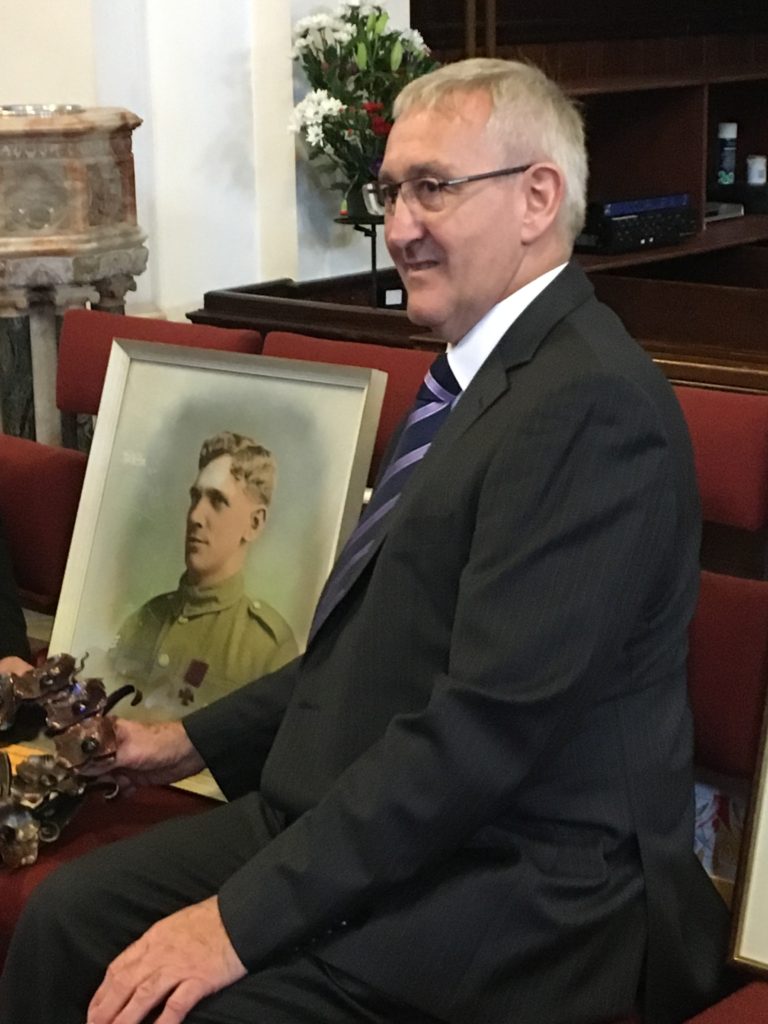
Brother Tom Carmichael Past Master of Lodge Coltswood Glenboig No 1067
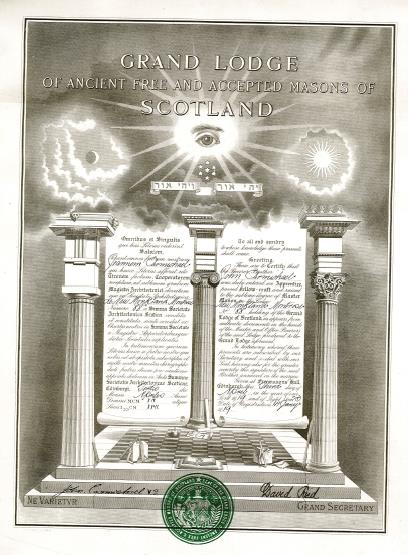
Bro. John Carmichael VC Master Mason Diploma – Lodge New Monkland Montrose No. 88
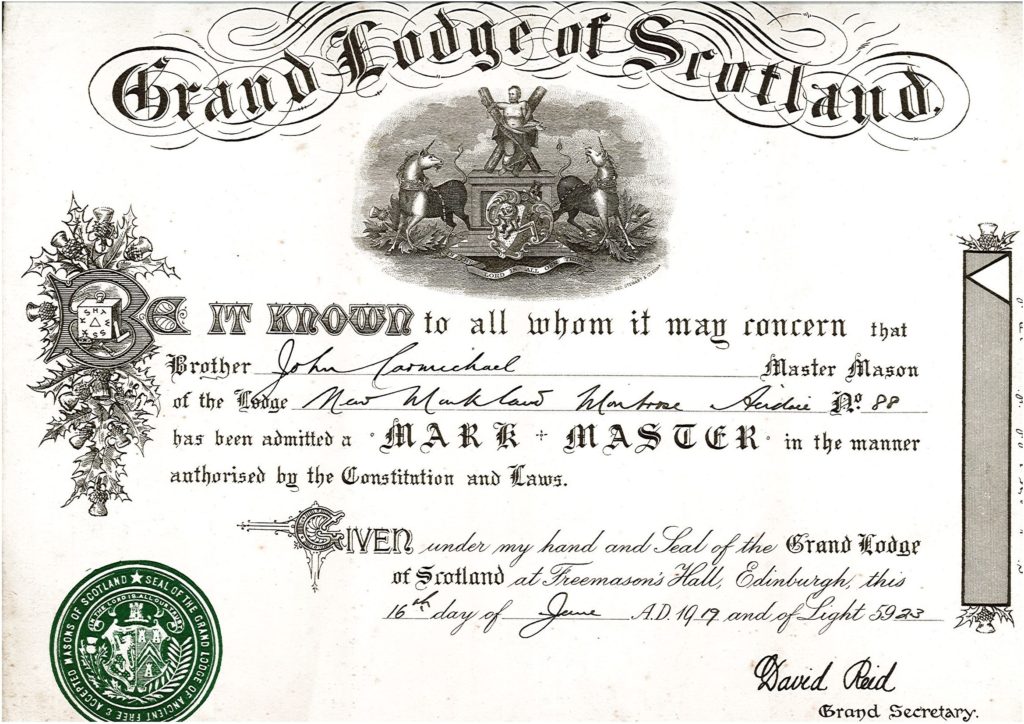
Bro. John Carmichael VC Mark Master Mason Diploma – Lodge New Monkland Montrose No. 88
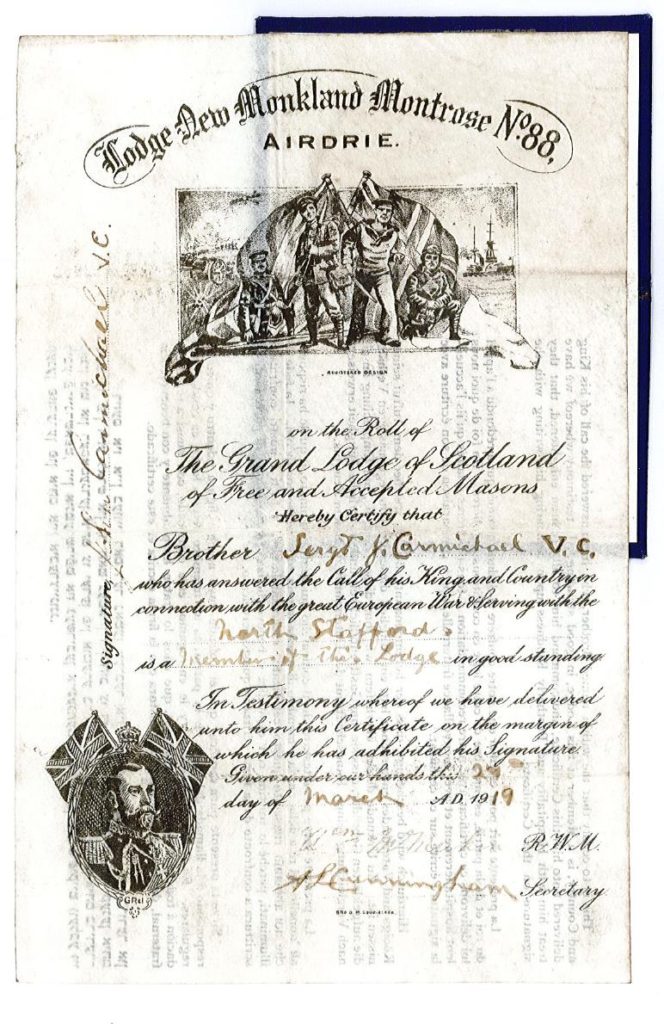
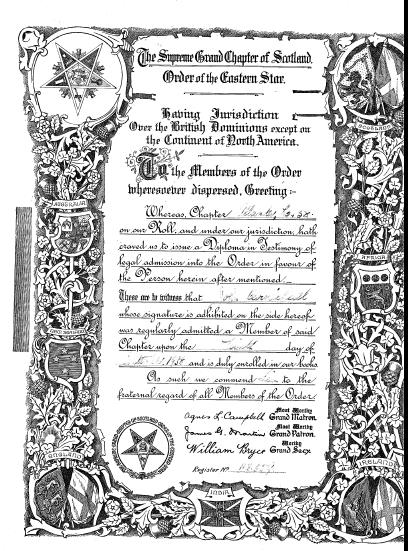
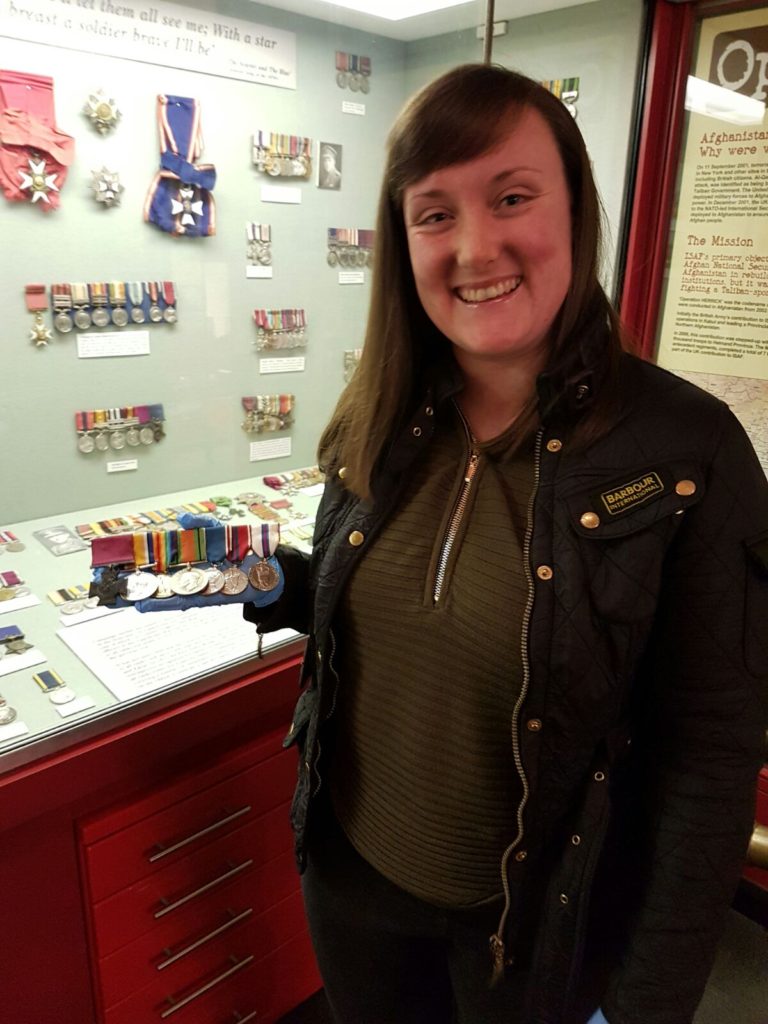
Lorna Carmichael viewing the medals at the North Staffordshire Regimental Museum